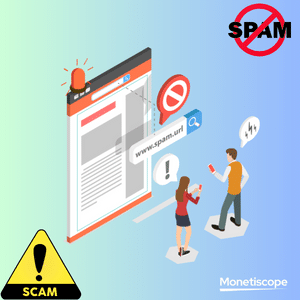In the ever-evolving landscape of digital advertising, the persistent threat of click spam demands a deeper understanding. This comprehensive exploration by monetiscope aims to provide in-depth insights into various click spam types, their profound impacts on major platforms like AdX and AdSense, and effective strategies to fortify your website against these deceptive practices.
Understanding Click Spam Tactics: A Detailed Examination

1. Bot Clicks:
Automated bots, programmed to simulate user engagement, generate fraudulent clicks with the intent to manipulate Click-Through Rates (CTR) and distort engagement metrics. This deceptive strategy aims to mislead advertisers by inflating the apparent user interest in ads.
2. Manual Click Fraud:
Manual click fraud involves deliberate actions by individuals to excessively click on ads. Often orchestrated by competitors or malicious actors, this intentional act aims to dilute the quality of ads, hampering user experience and diminishing the overall effectiveness of digital campaigns.
3. Pixel Stuffing:
Pixel stuffing is a deceptive technique where oversized ads are hidden within tiny pixels. This leads to unintended clicks when users interact with unrelated content. Advertisers are misled, and the credibility of digital advertising platforms is compromised due to this strategy.
4. Ad Stacking:
Ad stacking involves overlapping multiple ads in a single ad space, creating confusion and unintentional clicks. This tactic distorts engagement metrics, challenging advertisers in accurately assessing the performance of their campaigns.
Impacts of Click Spam on AdX and AdSense: Unveiling Consequences
1. Misallocation of Budget:
Click spam significantly distorts performance metrics, leading advertisers to misallocate budgets based on false engagement data. Advertisers may unknowingly allocate budgets without a true understanding of user interest, impacting the effectiveness of their campaigns.
2. Credibility Concerns:
Platforms like AdX and AdSense face credibility challenges when inaccurate metrics undermine the trust of advertisers. The credibility of these platforms is crucial for maintaining a trustworthy ecosystem for both advertisers and publishers.
3. Ad Quality Dilution:
High levels of click spam compromise the quality of ads, affecting user experience and diminishing the effectiveness of campaigns. This dilution hampers the achievement of desired results, impacting the overall success of digital advertising efforts.
Protecting Your Website: Advanced Strategies Against Click Spam
1. Implementing Click Fraud Detection Tools:
Advanced click fraud detection tools are essential for identifying and preventing click fraud. These tools use sophisticated algorithms to detect suspicious patterns, ensuring accurate engagement metrics and maintaining advertiser trust.
2. Monitoring User Behavior:
Proactively monitoring user behavior is crucial for identifying abnormal click patterns and taking preventive measures. Regular monitoring allows publishers to stay ahead of potential instances of click spam, fostering a secure digital advertising environment.
3. Setting Click Limits:
Establishing click limits for individual users or IP addresses is an effective deterrent against excessive clicks and fraudulent activities. This strategy contributes to a more secure digital advertising environment, discouraging malicious actors.
4. Enhancing Security Measures:
Strengthening website security is pivotal in deterring automated bots and malicious actors attempting to engage in click spam. This proactive approach ensures the accuracy of engagement metrics and maintains the trust of advertisers in the platform.
Examples of Click Spam Mitigation in Programmatic Advertising Platforms
1. AdX Click Quality:
Google AdX employs sophisticated algorithms to filter out invalid clicks, ensuring the reliability of engagement metrics. The platform’s commitment to click quality management contributes to a secure and credible digital advertising environment.
2. AdSense Click Fraud Protection:
AdSense incorporates robust click fraud protection mechanisms, including real-time monitoring and analysis. This commitment fosters a secure digital advertising environment, assuring both publishers and advertisers of a trustworthy platform.
Conclusion: Safeguarding the Digital Advertising Ecosystem with Knowledge and Vigilance
In the ever-evolving landscape of digital advertising, a nuanced understanding of click spam types, their impacts, and advanced protective strategies is paramount. Armed with this knowledge, publishers can fortify their websites against fraudulent activities, ensuring the longevity and effectiveness of their online advertising efforts. Staying vigilant, leveraging advanced tools, and fostering a secure digital ecosystem are key to navigating the challenges posed by click spam.


